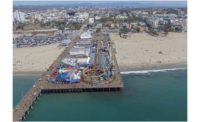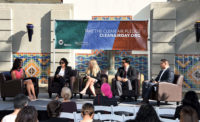Santa Monica currently requires all new residential and commercial construction to include rooftop solar systems. The Southern California coastal city of more than 92,000 people was the first city to require all new residential construction to be “zero-net” energy. Santa Monica has a water neutrality ordinance that caps water use for developments to the historical five-year average for the site. And the city is the first municipality to construct a super-sustainable Living Building.
The laws and programs, all since 2016, are part of the city’s ambitious three-part goal to achieve water self-sufficiency by 2020, zero waste production by 2030 and carbon neutrality by 2050.
The goals are outlined in the most recent update of the Santa Monica Sustainable City Plan, first adopted in 1994. “Santa Monica is always at the forefront,” says Rick Valte, the city engineer. “We hope what we do here is adopted by others.”
Related Article
Santa Monica Moves Forward on the Nation's
First Municipal 'Living Building'
There is more. The city just finished its $13.5-million Clean Beaches Initiative (CBI), designed to improve beach water quality and drought resiliency. The project included construction of a subgrade stormwater storage tank to harvest runoff from the Santa Monica pier’s drainage basin, which covers 106 acres. The harvested runoff will then be diverted for treatment at the Santa Monica Urban Runoff Recycling Facility (SMURRF) and distributed for nonpotable uses. Overflows from the tank will be discharged into the sanitary sewer system.
The CBI system will treat 150 million gallons of water each year. Valte is even more excited about the city’s Sustainable Water Infrastructure Project. SWIP consists of three elements. The first includes a modular reverse osmosis unit at SMURRF, a new shallow brackish and saline groundwater extraction well at the beach and new solar panels for energy offset. The second element includes a below-grade stormwater and sewer treatment facility at the civic center parking lot with a 1-million-gallon-per-day capacity. The third element consists of two new stormwater harvesting tanks at the city’s Memorial Park and the civic center lot, with a 4.5-million-gallon capacity.
“We are looking at economic vitality, social equity and environmental protection.”
– Shannon Parry, Deputy Sustainability Officer
The design phase for the nearly $70-million project is just beginning. Construction is expected to start next June. Completion is set for the fall of 2020.
On the renewable power supply side, Santa Monica has joined Los Angeles Community Choice Energy. LACCE, which has more than 30 city and other members in Los Angeles County, is a way to achieve community-wide reductions in greenhouse gas emissions from electricity generation by providing competitively priced electricity from renewable sources to homes and businesses.
“This gives options to consumers to use 100% renewable energy,” says Kevin McKeown, a member of the city council and former mayor who has been charged with coordinating the program, which he calls “a launch pad” for renewable energy production.
In February, service is scheduled to start for residential customers. Service for nonresidential customers is scheduled to start next summer. And to meet growing demand, LACCE has plans to build a solar power plant.
The city’s sustainable plan is “not just a green city initiative,” says Shannon Parry, the city’s deputy sustainability officer. “We are looking at economic vitality, social equity and environmental protection.”




Post a comment to this article
Report Abusive Comment